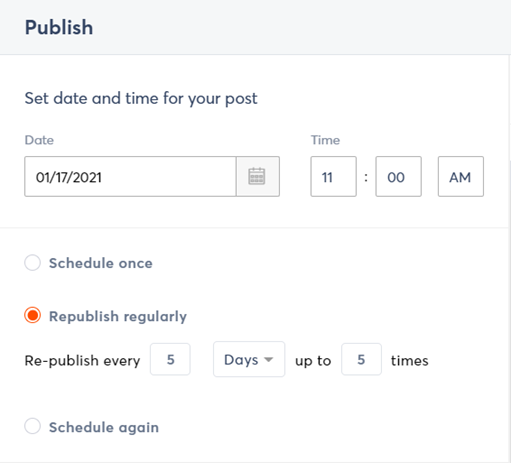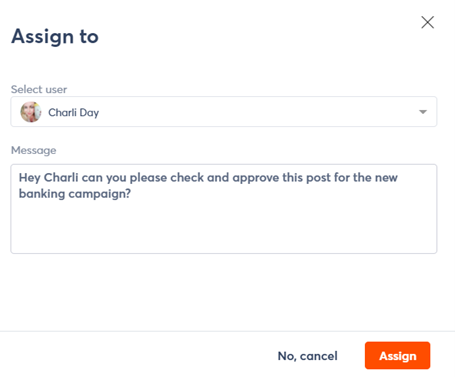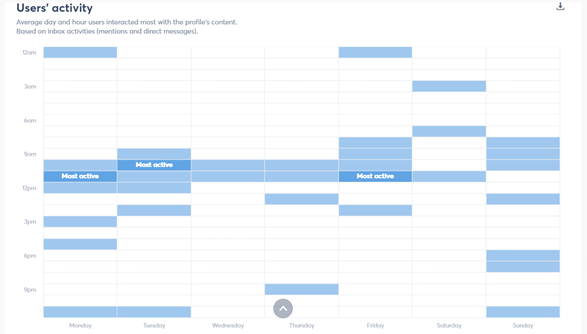How to use a social media tool to plan the year ahead

Posted: Tue 4th Jan 2022
2022 might seem like another year where plans are impossible. But for businesses, social media planning is essential for success.
In this blog, we'll show you how to use a social media tool to plan 2022 in five steps.
Why do you need social media planning?
Social media planning gives you time to create graphics and videos. It allows you to collaborate with team members and get sign-offs. It keeps you organised and able to plan for key sales opportunities like Valentine's Day or Halloween.
Perhaps most importantly, it allows you to take a holiday or enjoy a weekend off!
Five social media planning steps
1. Find your content
The content that goes into your calendar will depend on your sector and the specific days, hashtags, and events associated with it.
You can search popular trending days on sites like Days of the Year. By browsing those calendars, you can find days relevant to your sector.
These hashtags often trend heavily on social media, so you will get more traction on posts that include them on those days.
You can also add in your own dates, company events and special offers.
Pro tip: Make a note of some reputable sites that are not competitors from which you can share content. You can tag them within the calendar by using @ as you would directly on the social media platform.
2. Repurpose content
If you're a small business or start-up, you probably don't have the resources to create multiple campaigns with video, images and content.
But by repurposing content, your resources will go further. You can reuse old articles, reshare videos, and turn customer questions into social media posts.
Create an evergreen library of images that will match numerous social media posts. That means less pressure to create fresh images for your posts.
3. Make the most of your social media tool
Using a social media tool for planning can save you time when you're managing a number of different channels.
Here's how the social media calendar looks at Agorapulse.

On the left side are the different profiles for Twitter, Facebook, LinkedIn, and Instagram, and in the calendar are all the posts you've scheduled with times and dates for each.
Scheduling a post is simple. Just select the profile, choose the date/time and write the post. You can add images and videos to your posts too. Then just hit schedule and your post is in your calendar.
You can choose to schedule again or republish regularly. This allows you to show the post again in a different time zone or at the weekend. If you have a regular offer (e.g. 10% off on Fridays), you can schedule it for every Friday in the month.

Pro tip: Decide on a schedule that works for your company and resources. For example, Facebook: two per week, Monday and Friday; Twitter: at least twice per day, every day; Instagram: one to three times per week.
4. Keep your team in the loop
The best marketing hinges on good communication and a huge advantage of using a social media tool is that you can add team members.
Perhaps you want to add your designer, so they know to create images for scheduled posts. Your content writer so they can create matching blogs, or your manager who needs to approve posts.
If your company is legal or financial you might need to get compliance sign-off. Agorapulse makes doing so easy by allowing users to assign posts to others.

Pro tip: Not everyone needs access to the calendar, and too many editors can hold you back.
5. Play with social media planning hacks
Once you've learned the social media calendar basics, you can start experimenting with some expert planning hacks.
The inbuilt reporting that comes with the calendar allows you to see which posts are performing well and this will help guide your direction.
Here are some more hacks to try for yourself:
Start each week with a look at the calendar and what's happened over the weekend
It's possible you'll need to edit or delete scheduled posts if something happened over the weekend. The good news is that you can easily edit scheduled posts.
Add trending content
Not everything can be scheduled, but you can easily add trending content to your calendar on the fly. You can analyse its success in your reporting panel.
Repeat content at different times
The easy reporting will show you which times get the most engagement, so you can adapt future posts.

Remember your target audience and product
If you're promoting a 50% off for the next hour flash sale at the wrong time, you won't get many clicks. Always work out your target time zone and set the calendar accordingly.
Reward top fans and find ambassadors
The advanced reporting in the social media calendar allows you to find your top fans. This is also a great opportunity to seek out micro-influencers or ambassadors to help further promote your brand.

Run the same post with different images
Just as you might split test a web page or landing page, a social media calendar makes it easy for you to test your content or images. Try posts with different hashtags, or use the same text with different images.
Create draft answers
Creating draft templates ahead of time and having them approved is a huge time saver. It also ensures great spelling and on-brand company responses. Not every social media reply can be standardised, but good examples could include your returns policy, shipping times or COVID-19 safety questions.

